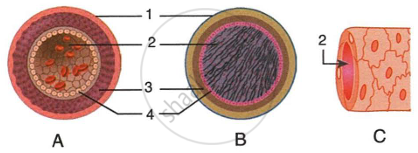Advertisements
Advertisements
Question
The figures given below show diagrammatic cross sections of three kinds of blood vessels.
 |
- Identify the blood vessels A, B and C.
- Name the parts labelled 1-4.
- Mention two structural differences between A and B.
- Name the kinds of blood that flow through A and through B respectively.
- In which one of the vessels referred to in (a) above does the exchange of gases actually take place?
Solution
- A - Artery, B - Vein, C - Capillary
-
- Tunica Externa
- Lumen
- Tunica media
- Endothelium
- An artery has thick muscular walls and a narrow lumen. It does not have any valve.
A vein, on the other hand, has thin muscular walls and a wider lumen. It has valves to prevent backflow of blood. - A (Artery) - oxygenated blood, B (Vein) - deoxygenated blood.
- At the capillary level, the actual exchange of gases takes place.
APPEARS IN
RELATED QUESTIONS
Write the function of valves present in between atria and ventricles.
Describe the functions of Red blood cells.
Describe the functions of Blood.
Define the term Veins.
How many litres of blood does an adult human body have?
Name the iron containing protein present in RBC of blood.
Study the following diagram carefully:
(a) With which figure in the chapter can you roughly compare this diagram?
(b) Write any two things shown in it as extra from those in the figure named above.

Complete the following sentence with appropriate word:
The blood vessel leaving the left ventricle of the mammalian heart is the _________.
The pH of the blood is maintained by ____________.
The substances to and from the tissues diffuse through the walls of ______.
